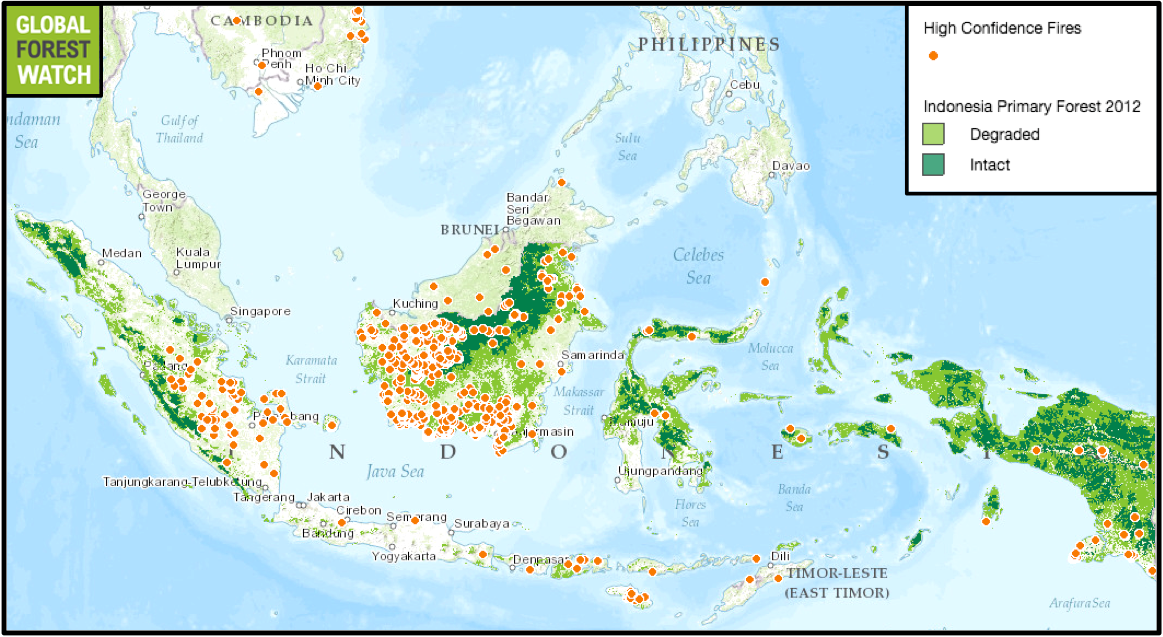- Haze from Indonesian fires is causing regional health problems and potentially contributing to climate change.
- Many fires are destroying valuable wildlife habitat.
- The impending El Nino weather pattern may make this year’s dry season – and subsequent fires – worse than usual.
This is the first in a two-part series on forest fires in Indonesia, their effects, and what’s being done to stop them. Read the second part here.
The annual burning of Indonesian rainforests represents an example of the increasing clouding of regional-global divides when it comes to environmental problems.
Many Southeast Asians are wondering if they will have to withstand another blanket of haze from rainforest fires as Indonesia enters its annual dry season. Signs of an impending El Nino weather pattern mean the country’s traditional dry period this year could extend from May to August into September.
In the past, Indonesia’s dry season has often coincided with extensive fires – many deliberately lit – that have resulted in palls of smoke that recognize no borders and threaten to foul the lungs of Indonesians and their neighbors, while exacerbating concerns for children’s long-term health. So far, the ASEAN Haze Monitoring System – which incorporates satellite pictures and maps – has detected a total of 4,763 hotspots, indicating wildfires, across Indonesia between 1 January and 23 July this year.

The effects of cross-border haze from Indonesia have different manifestations. For people living in Indonesia and surrounding countries it is a smoky blanket that blocks out the sun. For the world’s global citizens, the effects of the haze are less apparent, but potentially more insidious as they spread over generations. This is because the growing spectre of climate change now adds an international dimension to this perennial problem.
The burning of Indonesia’s rainforests puts this country in the top echelon of the world’s greenhouse gas emitters. The UN estimates the conversion of forests to other land uses is responsible for nearly 20 percent of net global carbon emissions, more than the entire global transportation sector and second only to the energy sector. A World Bank – UK aid report in 2007 found that Indonesian forest fires were responsible for about a third of global emissions from tropical deforestation.
Haze riles Indonesia’s neighbors
While the future effects of untrammelled climate change are projected to be devastating on a global scale, they must address this problem in the here and now to assuage regional concerns. Two years ago, Indonesian forest fires set off the region’s worst pollution crisis in a decade, while sparking regional tempers.
“No country or corporation has the right to pollute the air at the expense of Singaporeans’ health and wellbeing,” Singapore’s Environment and Water Resources Minister Vivian Balakrishnan, declared on his Facebook page in June 2013. The minister’s comments followed cross-border haze sourced from Indonesia pushing the island state’s pollutant standards index to 371, 71 points above what is considered to be “hazardous” to people’s health.

Southeast Asian leaders understand the need to work together to address the haze problem. In September last year, Indonesia’s parliament ratified a regional agreement on cross-border haze. Indonesia is now vying with Malaysia to host an ASEAN secretariat to deal with the problem. While signs of regional cooperation are promising, the potential for further flare ups is also evident.
In March of this year, Indonesian Vice President Jusuf Kalla issued a broadside against neighbouring countries’ complaints about the haze. “For 11 months, they enjoyed nice air from Indonesia and they never thanked us,” Indonesian press quoted him as saying. “They have suffered because of the haze for one month and they get upset.”
Singapore’s Environment and Water Resources Minister was again adamant that Indonesian fires need to be curtailed sooner rather than later during the 17th regional meeting called to address the transboundary haze problem at the end of July.
“As far as Singaporeans are concerned, we want a haze-free ASEAN now, not in 2020. We want it now. The human, social and economic cost of haze in our part of the world has been too high and been going on for far too long,” Vivian Balakrishnan said in a meeting with five ASEAN representative members, including Indonesian Environment and Forestry Minister Siti Nurbaya Bakar, according to the Jakarta Post.
International pressure builds on Indonesia
A storm of outside pressure has gathered around Indonesia from its neighbors and the wider international community to stop the haze and help combat climate change. The 2007 World Bank-UK aid report exacerbated this pressure after finding that forest fires, deforestation and peat land degradation put Indonesia in the world’s top three greenhouse gas emitters, behind China and the United States. More recent calculations by the World Resources Institute bring Indonesia back to sixth global emitter. Nevertheless, the international impetus on Indonesia to stem the burning of its forests has not abated.

The damage from the fires, of course, is not all about regional haze and climate change. The clearing of rainforests is also destroying invaluable reserves of plants and animals. Indonesia is ranked as the fourth most biologically diverse country in the world. The protection of these forests from burning would consequently help safeguard their unique inhabitants, such as the orangutan. The Bornean orangutan (Pongo pygmaeus) is listed by the IUCN as Endangered and the Sumatran orangutan (P. abelii) Critically Endangered, due primarily to destruction of their forest habitat.
As in many cases, trying to find an equitable path through the sometimes-uneasy balance between environmental protection and development is not easy. Many forests have been felled and burned in Indonesia to open up land for palm oil plantations and to produce paper and wood products for an ever-expanding global market.
Six years ago, Indonesia enacted a moratorium banning the establishment of new commodity concessions such as oil palm and wood fiber plantations in primary forest. However, some are concerned the moratorium doesn’t go far enough, with exemptions when it comes to secondary forest and “national development” activities.
A real challenge in solving Indonesia’s regional haze-climate change conundrum lies in finding ways to avoid rainforest destruction while safeguarding the livelihoods of its citizens. At the most basic level, this involves generating profits for Indonesian people to make it worth their while not to burn forests.